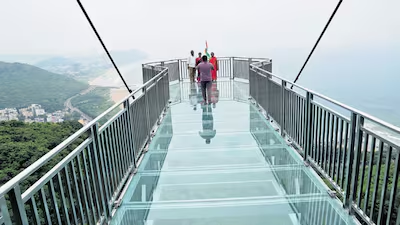On the eastern edge of Andhra Pradesh, where the Bay of Bengal crashes against the coast and the Eastern Ghats rise in the distance, a new structure has quietly taken shape. Later this month, Visakhapatnam will open India’s longest cantilever glass skywalk — a feat of engineering and ambition designed to reframe the city’s identity as a coastal tourism hub.
Engineering at the Edge
The bridge, suspended from the Kailasagiri Hills nearly 862 feet above sea level, extends 55 meters into open air — longer than any similar skywalk in the country. Its floor is built with three layers of imported German glass, each pane 40 millimeters thick, bound together with laminated safety technology and reinforced by 40 tonnes of steel. Engineers say the structure can withstand winds of up to 250 kilometers per hour.
While its foundation is built to hold more than a hundred visitors at once, authorities will allow no more than forty people at a time, a measure meant to balance thrill with caution. From the glass floor, visitors will see the ocean stretch endlessly eastward and the dense sprawl of Visakhapatnam fade into the hills on the west.
A Calculated Investment
The project, which cost approximately ₹7 crore, was executed through a public–private partnership under the guidance of the Visakhapatnam Metropolitan Region Development Authority. For local officials, the skywalk is more than a tourist attraction — it is a statement that Vizag can compete with the spectacle of other global coastal cities.
Andhra Pradesh has made tourism a central pillar of its development strategy, banking on natural assets like beaches, valleys and hill stations while adding built attractions to strengthen its profile.
Between Spectacle and Symbol
For years, Visakhapatnam has lived in a paradox: a port city that serves as an industrial hub while aspiring to be a leisure destination. The skywalk, set against sweeping views of sand and surf, is designed to reconcile that image — an emblem of leisure balanced atop a city better known for its steel plants and shipyards.
Whether it becomes a global destination remains to be seen. What is certain, however, is that when the first visitors step onto its glass floor, they will be suspended between land, sea and sky — and between the competing identities of a city determined to be seen anew.


